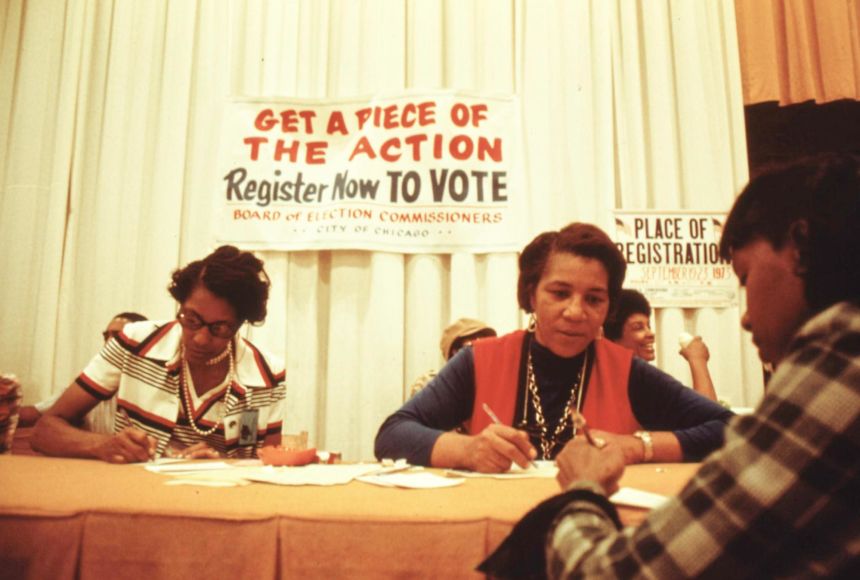The right to vote—and who may exercise it—has changed continuously over the course of United States' history. While states have traditionally determined requirements for voting, the federal government has taken several actions that have altered those requirements in an attempt to create more equity and equality in the process. Today, in order to vote in federal elections, one must be a United States citizen, at least 18 years old by the date of the general election, and a resident of the state in which one votes. However, these requirements used to be more restrictive.
Voting After the American Revolution
Following the American Revolution, the new country transitioned from a period of being under British rule to developing its own government. After the failure of the Articles of Confederation, the country adopted the United States Constitution in 1787. Article 1 of the Constitution empowers state legislatures to oversee federal elections. Suffrage, or the right to vote, was granted exclusively to white, land-owning men. Since they were at such an early stage of the republic, the founders believed these men’s economic ties to the country were valuable.
However, a growing number of men began to champion an expansion of suffrage during the early 1800s. Following a period that lacked political parties or choices for voters, the 1820s saw the return of a two-party political system, as well as a renewed interest in suffrage. White men continued to move West in search of available land, but many did not feel that ownership should be a requirement for voting. Many states removed that requirement, opening the door for complete white male suffrage.
Voting After the Civil War
While the country celebrated the expansion of voting rights for white men of all economic levels, the electorate still lacked diversity. Gender and race exclusions still restricted the ability of many citizens living within the United States to exercise the right to vote. Following the conclusion of the American Civil War in the 1860s, the Radical Republicans controlled Congress. These men were primarily white Northerners who wanted to restrict the political power of the South following its rebellion against the U.S. federal government. As a result of the 13th Amendment, a large number of African Americans living in the South were freed from slavery, in addition to the many living in the North. Radical Republicans saw this as an opportunity not only to help their own cause, but also to extend suffrage to African American men. In 1870, the 15th Amendment to the U.S. Constitution was ratified, declaring that the "right of citizens of the United States to vote shall not be denied or abridged by the United States or by any state on account of race, color, or previous condition of servitude."
The ratification of the 15th Amendment, which affirmed the right of African American men to vote, followed that of the 14th Amendment, which classified anyone born in the United States a citizen. The 14th Amendment also granted "the equal protection of the laws" to all citizens. While this amendment became the basis for citizenship, along with the Indian Citizen Act of 1924 (this allowed for Native Americans to vote but did not enforce the right; it would take 40 more years until all U.S. states granted full suffrage to Native Americans), it would also be cited more than any other in litigation. The 14th Amendment would also be at the center of the civil rights movement, which attempted to combat discrimination African Americans faced for nearly a century after its passage.
African Americans faced Supreme Court challenges (Plessy v. Ferguson, 1896) that condoned separation of the races, as well as challenges at the polls. Having to pay a poll tax and pass a literacy test were just some examples of legalized state discrimination that African Americans faced in their attempts to exercise their right to vote. Many also faced threats of violence, lynching, and other scare tactics. It was not until the 1960s that the federal government more effectively protected their right to vote. After a series of speeches, sit-ins, and marches in Selma, Alabama, and other cities in the South, the 24th Amendment—which abolished poll taxes—and the Voting Rights Act of 1965 protected the right to vote for African Americans and others. In the 2013 case Shelby County v. Holder, the Supreme Court weakened the Voting Rights Act. Specifically, the court struck down a section of the law that required states with a history of race-based voter discrimination to gain federal approval before changing their election rules.
The Fight for Women’s Suffrage
Women were important supporters of the abolition movement in the mid-19th century, as they saw parallels with their own inequality during the period. A women’s rights movement developed around the 1840s under the leadership of women such as Elizabeth Cady Stanton and Lucretia Mott. At the Seneca Falls Convention in 1848 they introduced the “Declaration of Sentiments,” which included a revision to the Declaration of Independence, that “all men and women are created equal.” While their attempts to achieve women’s suffrage were unsuccessful at the time, they inspired future campaigners.
Wyoming was the first state to give women the right to vote in 1869, but it was not until 1920 that white women were granted the ability to vote nationwide. African American women continued to face obstacles to vote for many years following the 19th Amendment. The Progressive movement’s reforms and women’s work in industry during World War I helped drive support. The National American Woman Suffrage Association’s constant protests, campaigning, and marches finally gained support from prominent politicians, such as President Woodrow Wilson, following the war. It was a catalyst that led more women to become involved in politics and government.
The ratification of the 26th Amendment in 1971 lowered the voting age to 18, extending suffrage to more young adults.
